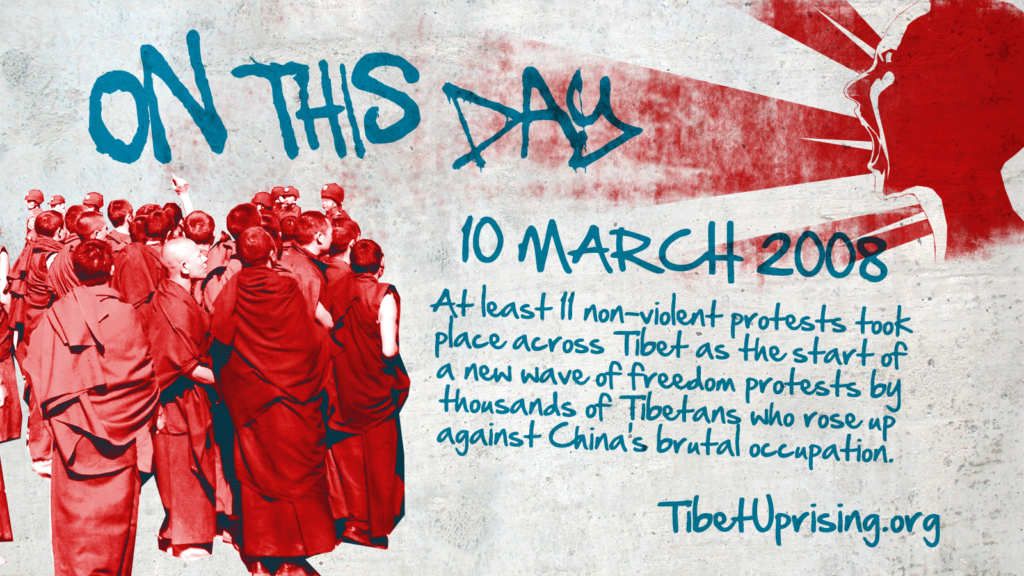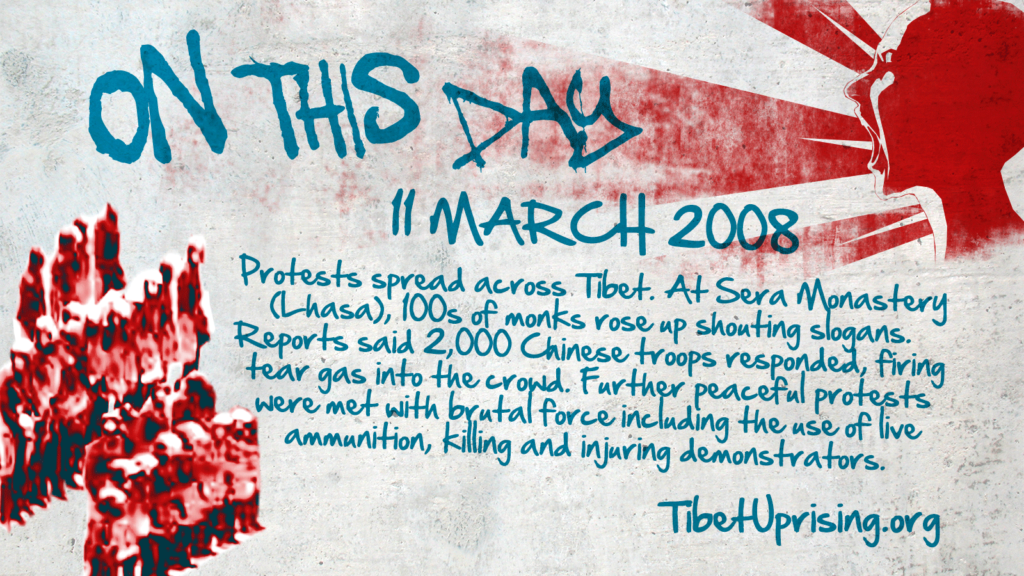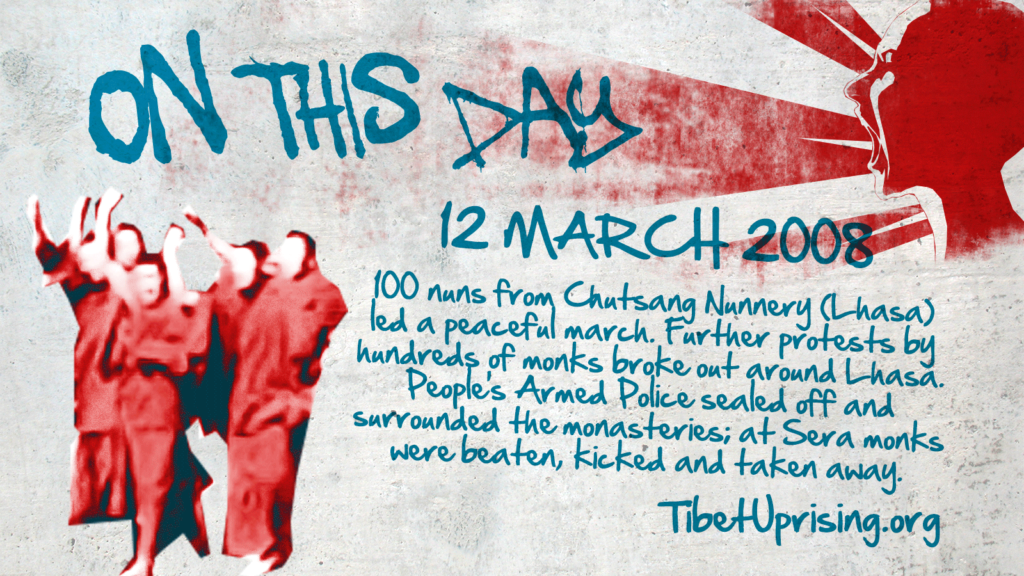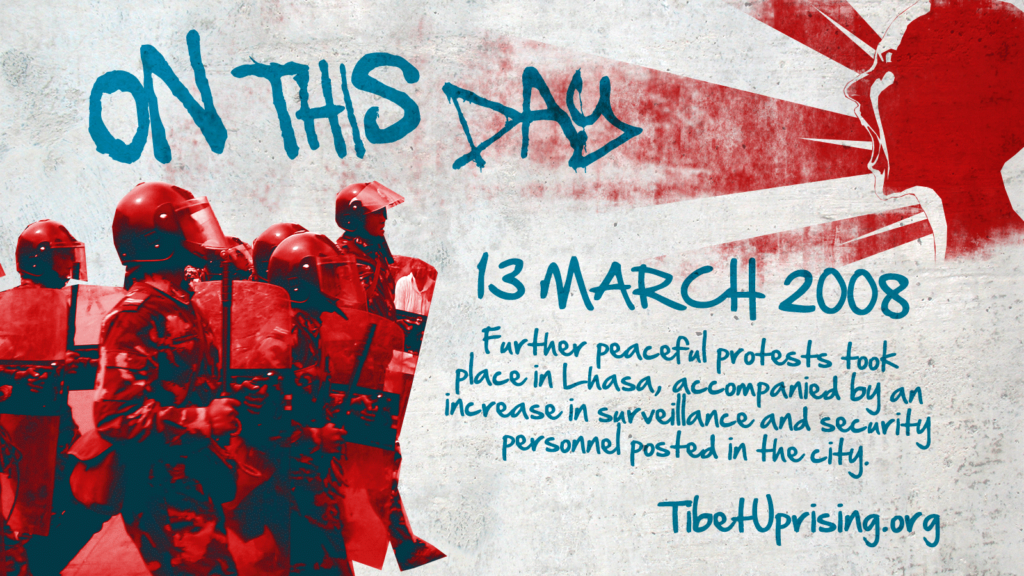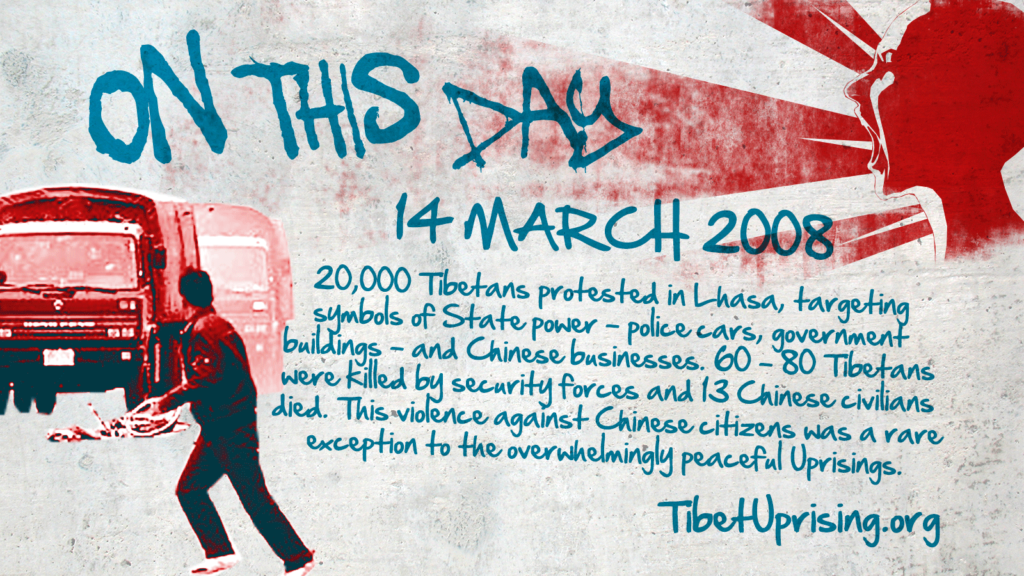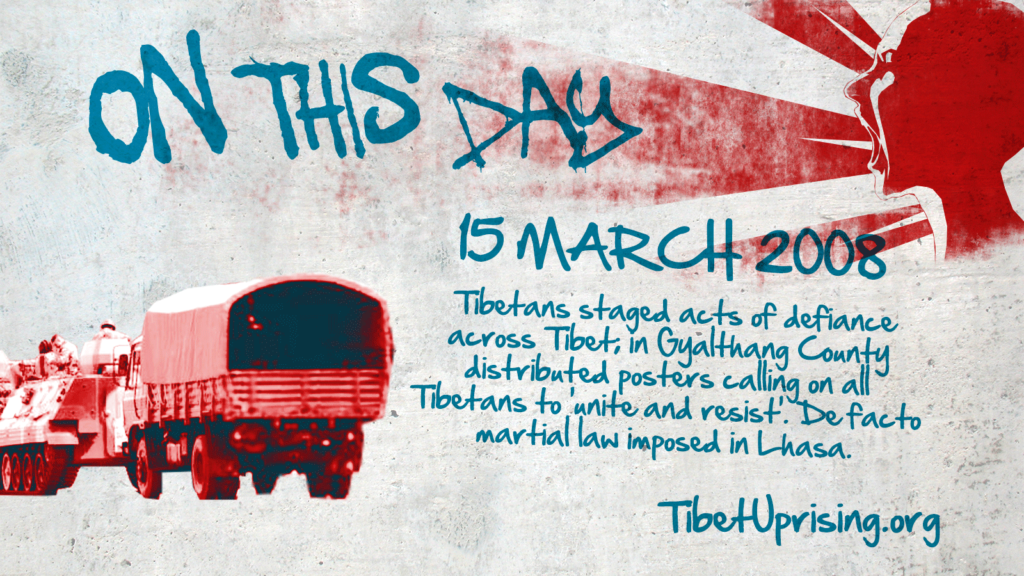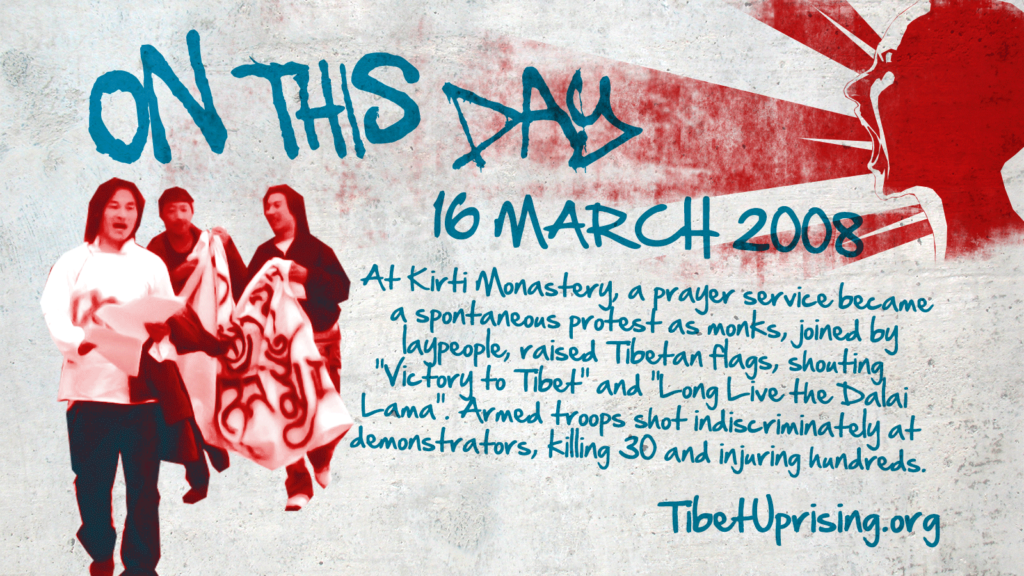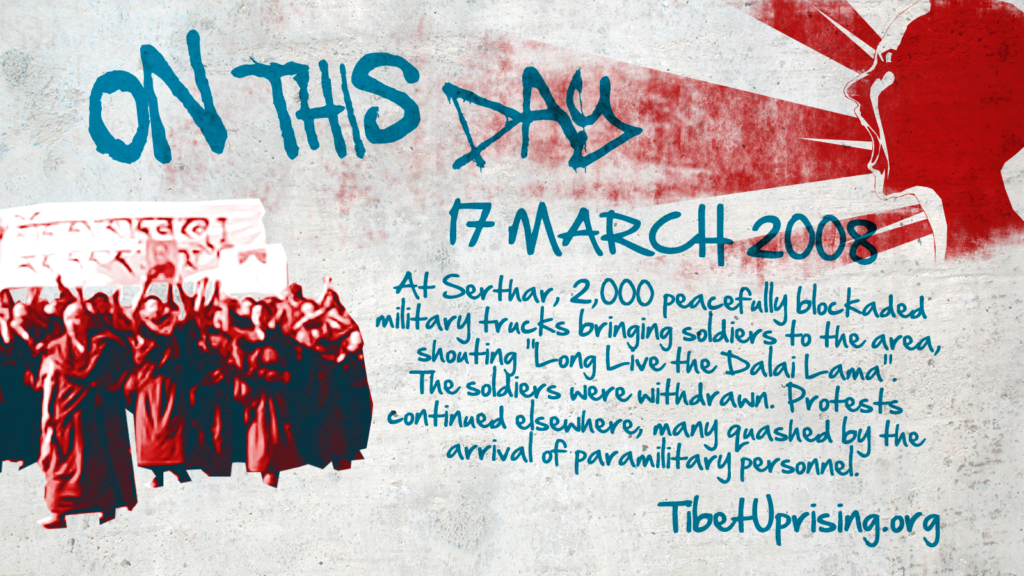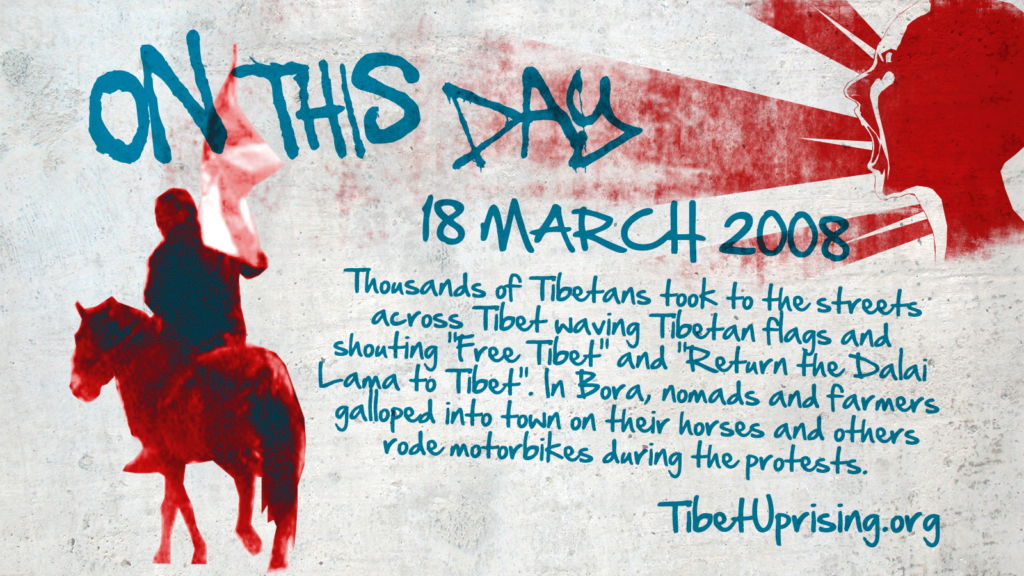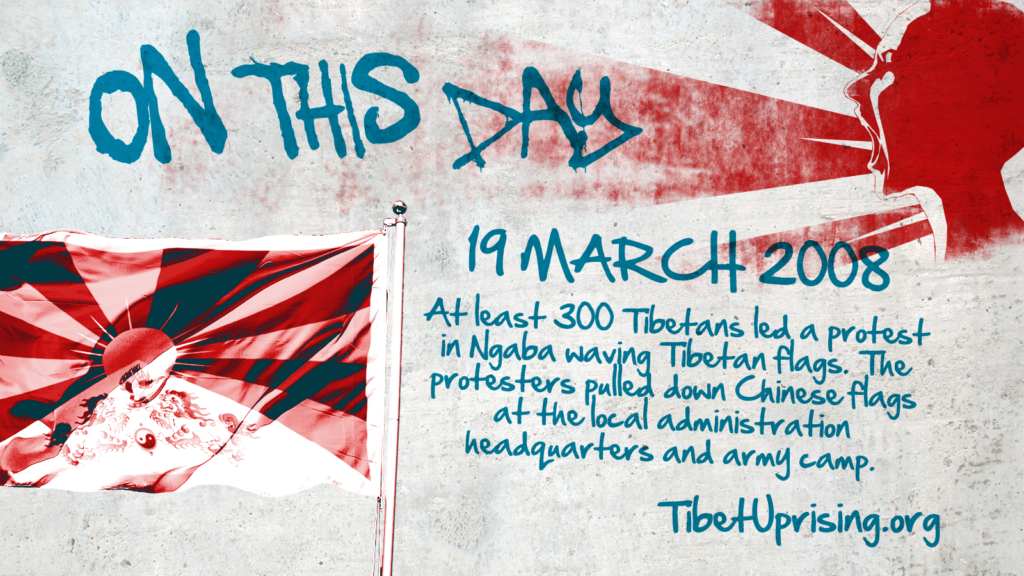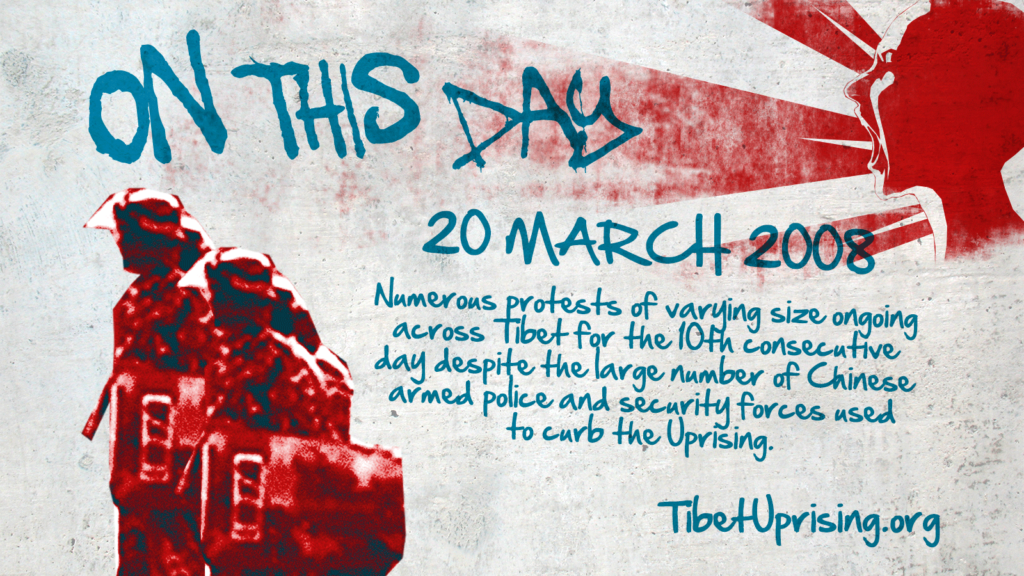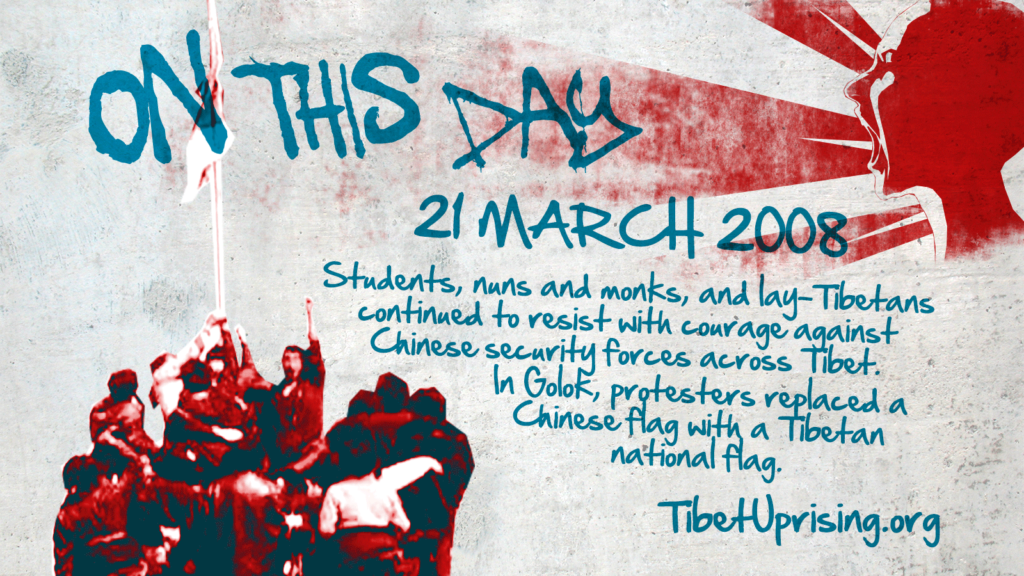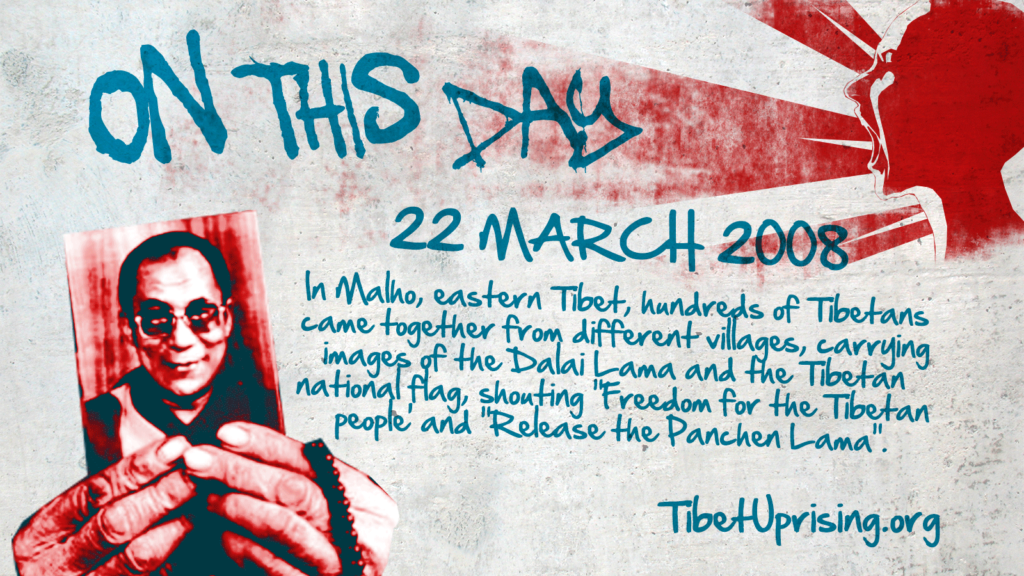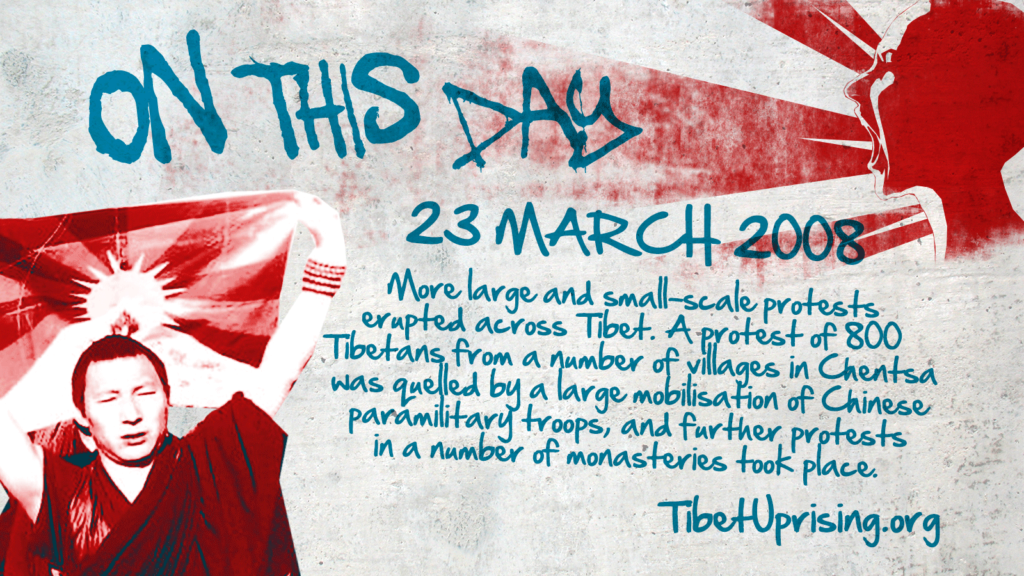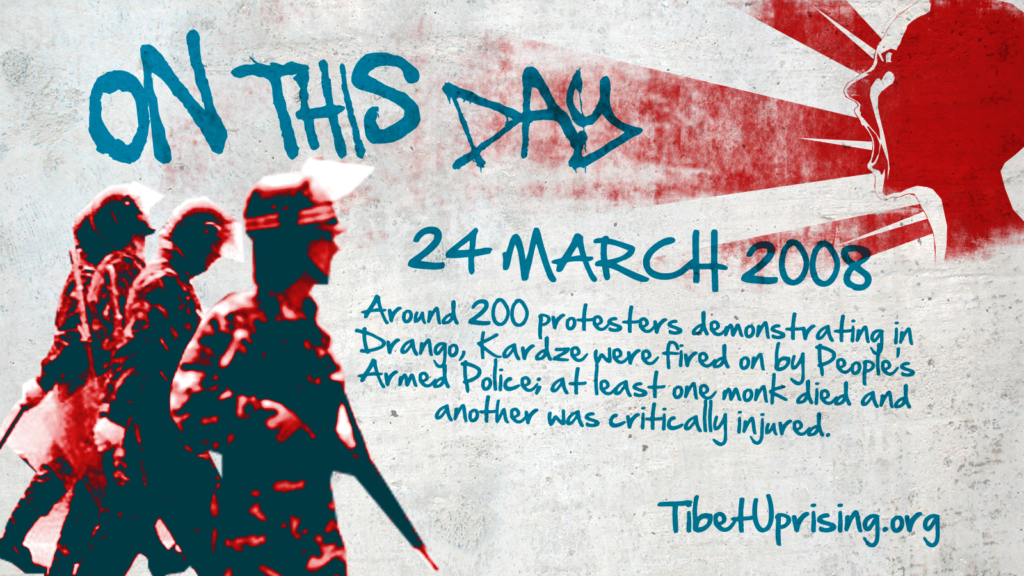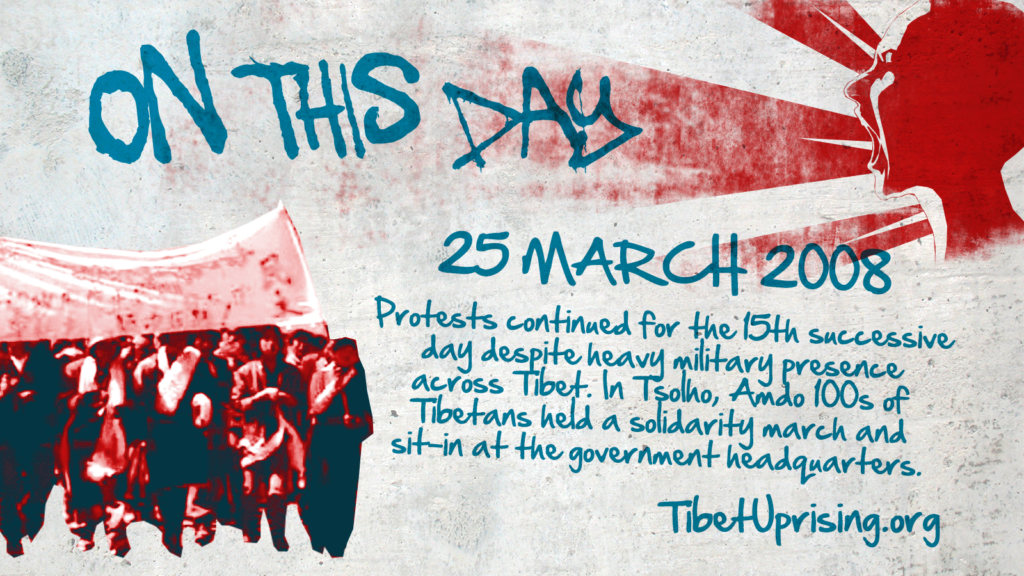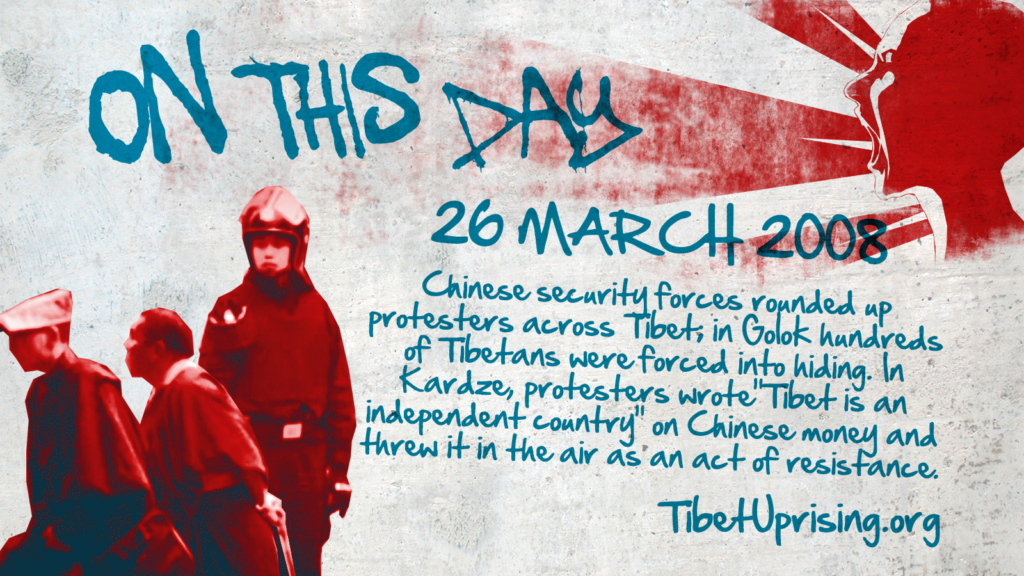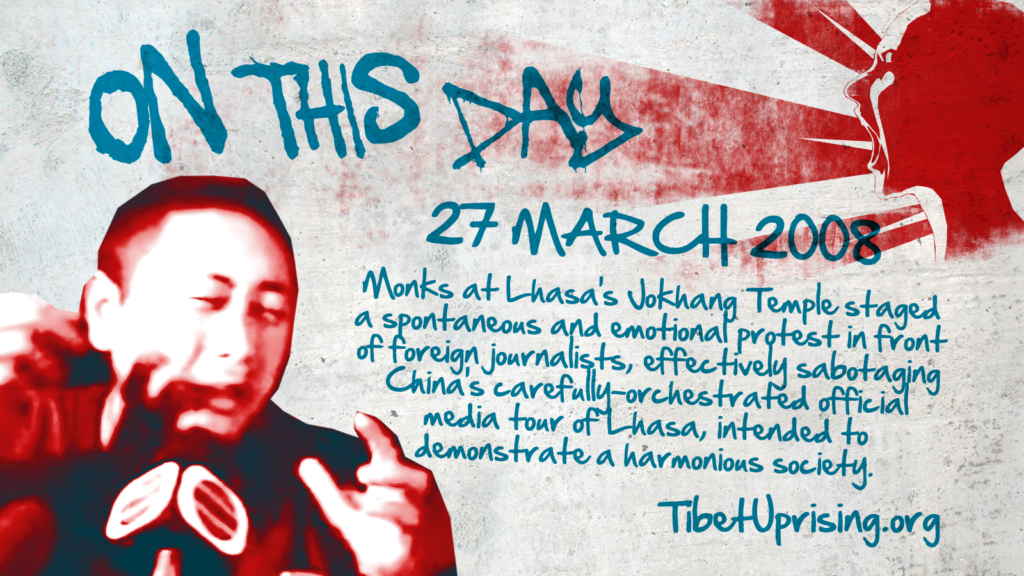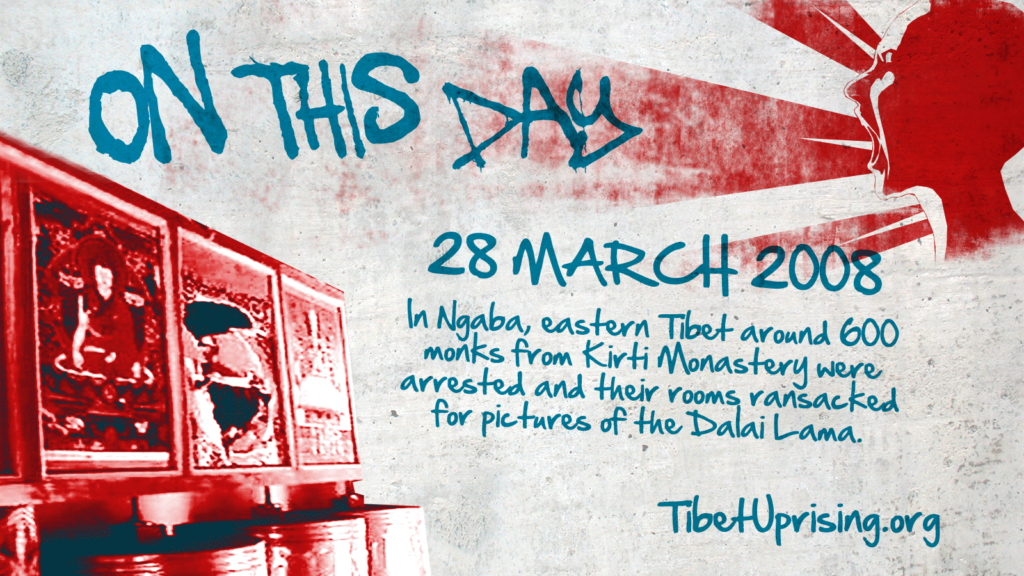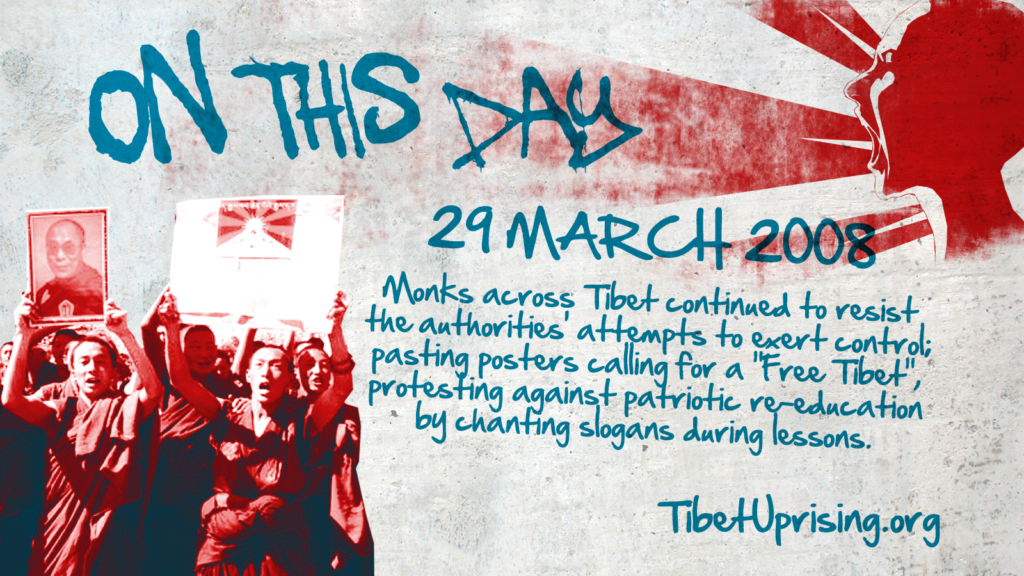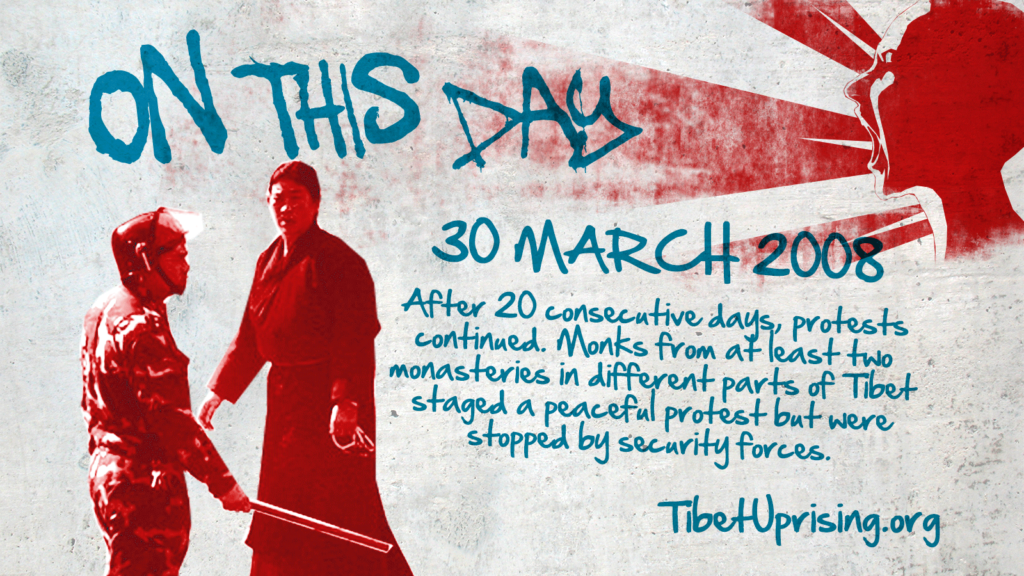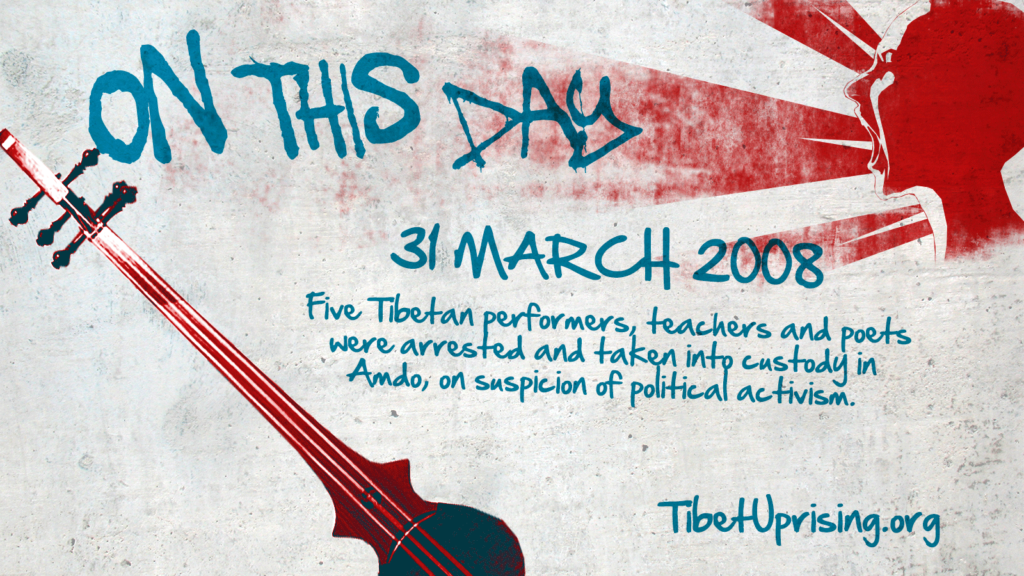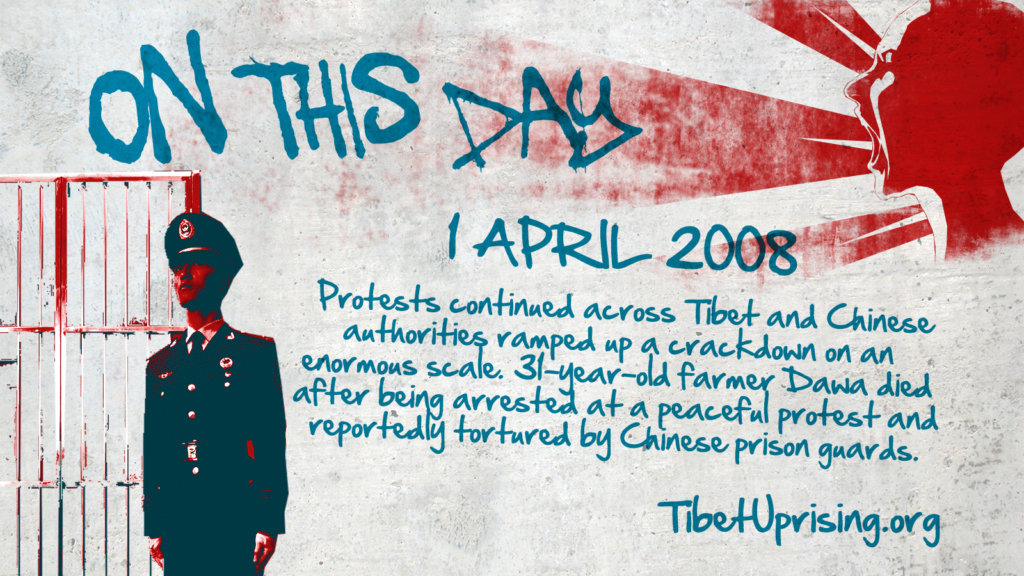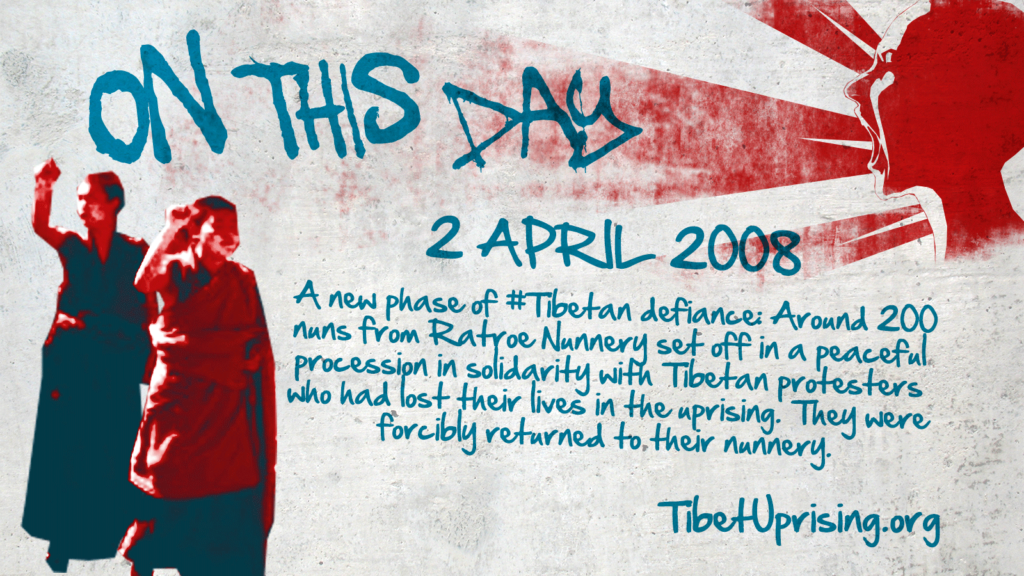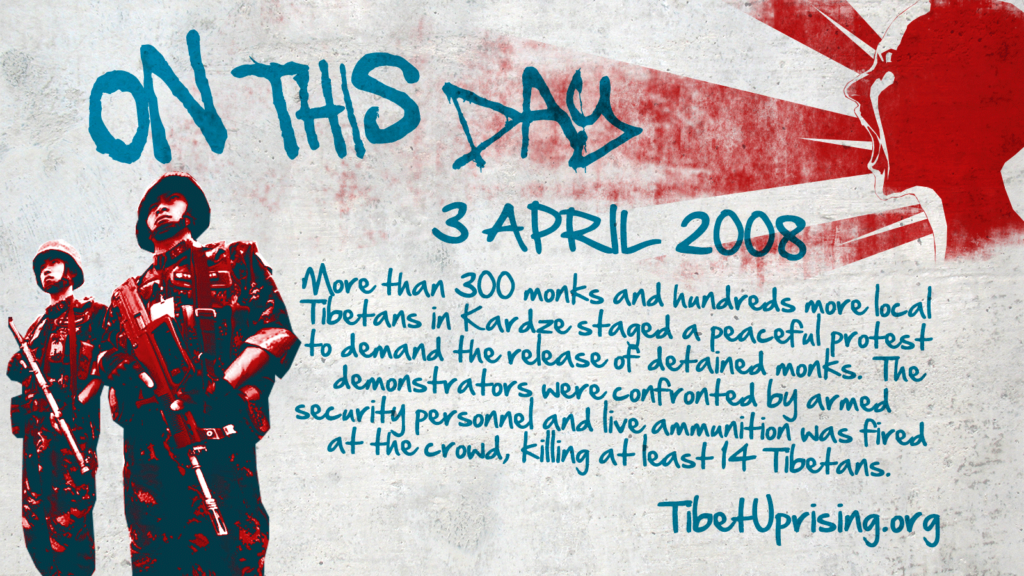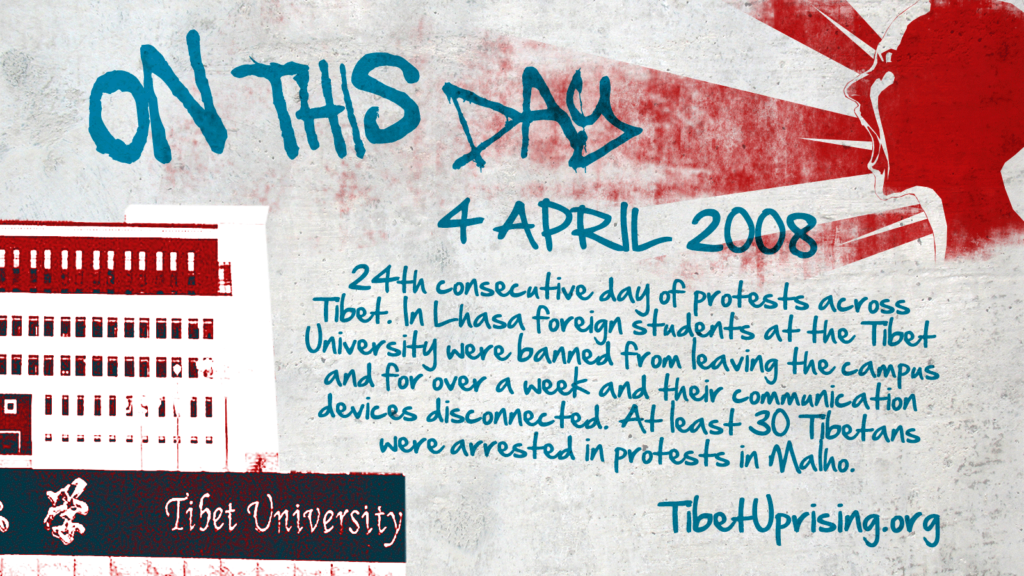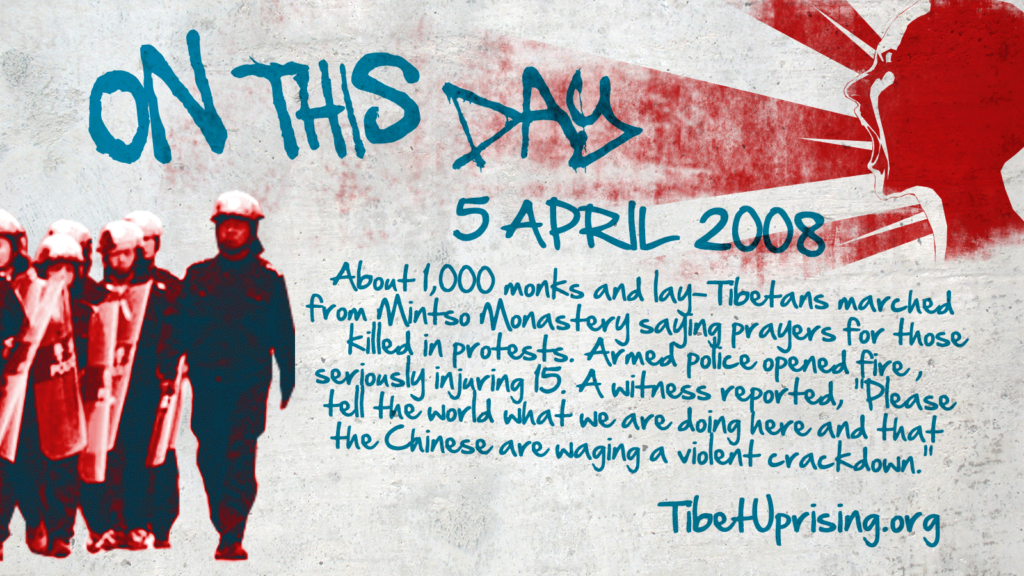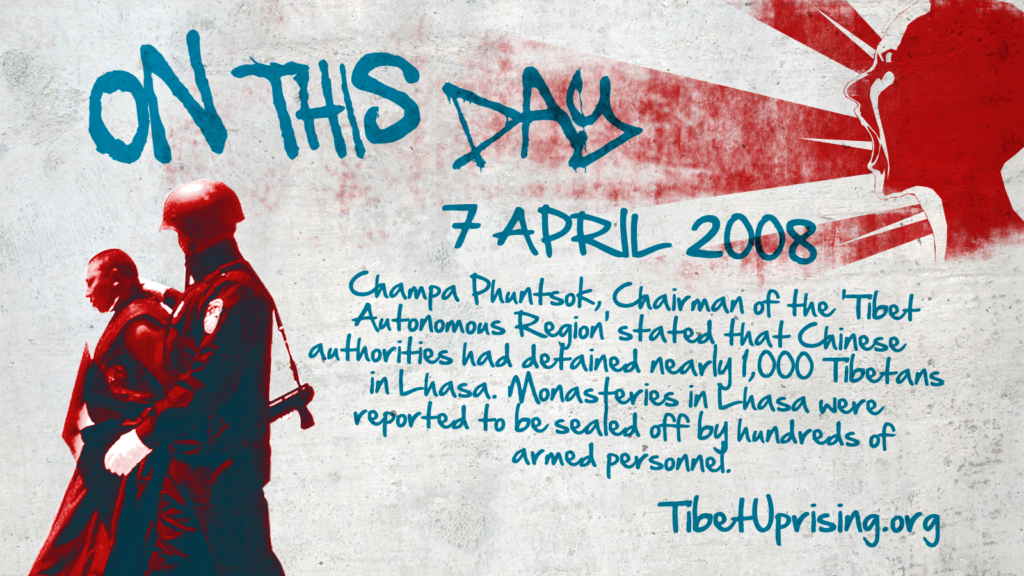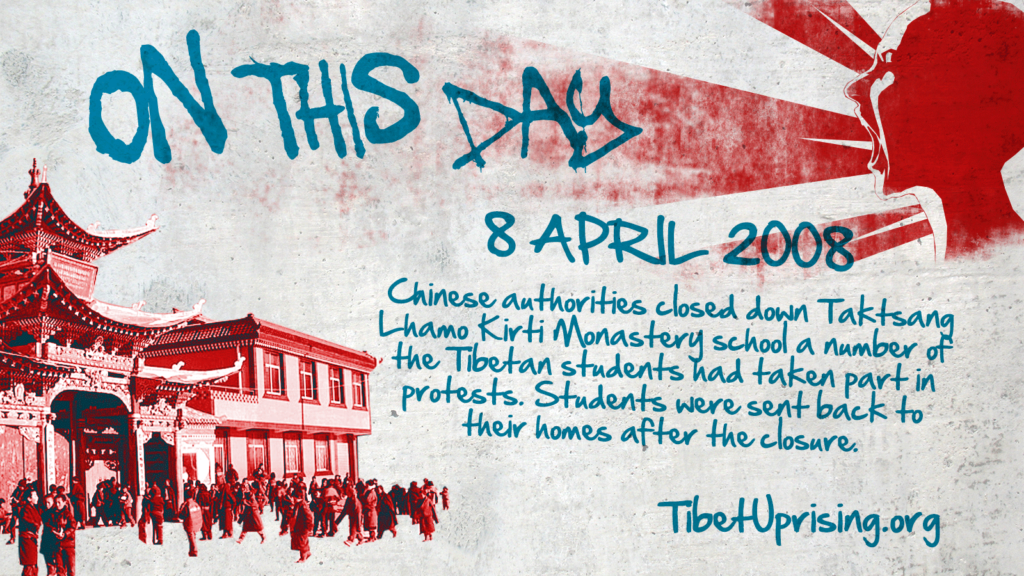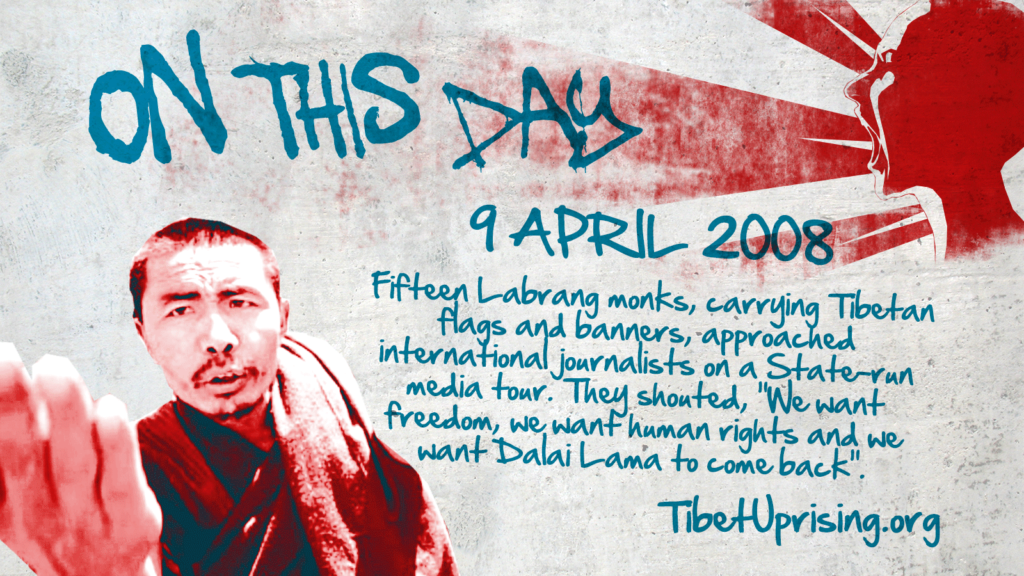Tibet Uprising 2008 Timeline
At least 11 recorded non-violent protests across Tibet, including –
Drepung Monastery where at least 300 monks started a peaceful march towards Lhasa city centre. Chinese authorities halted their progress with a large contingent of armed police.
Sera Monastery, around 20 monks and lay-people joined a peaceful pro-Tibet march to the busy Lhasa city centre raising Tibetan national flags, shouting pro-independence slogans and distributing leaflets. Police quickly arrived and severely beat the protesters and took them into detention.
Kardze County, hundreds of Tibetan independence leaflets were posted around the town.
Ditsa Monastery, monks from Ditsa Monastery in eastern Tibet walked out of an official Chinese authority meeting displaying a large portrait of the Dalai Lama and shouting pro-independence slogans.
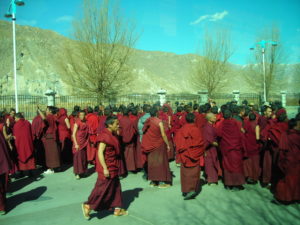
Protests continued to grow across Tibet – Hundreds of monks at Sera Monastery staged a peaceful protest calling for the release of detained monks and shouting pro-Tibet slogans. The protest was met with around 2,000 Chinese troops who fired tear gas into the crowd. Labrang Tashikyil Monastery, pro-independence leaflets were distributed, and in Kardze, eastern Tibet a large peaceful protest was met with brutal with force with police firing live ammunition at demonstrators, killing three and injuring a further ten.
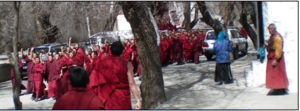
Hundreds of monks and nuns continued to protest. Monks from Ganden Monastery staged a sit-in protest, which was met with security personnel who fired tear gas to try to disperse the protesters. At Sera Monastery at least 600 monks marched from the monastery in protest against China’s rule, while hundreds more staged a non-violent demonstration in the monastery; Chinese police used force to stop protesters; an eye-witness reported that the police were “kicking and beating” the monks. Read the eye-witness report at BBC – Eyewitness: Monk ‘kicked to floor’
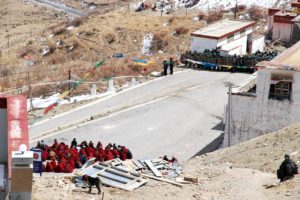
Further peaceful protests took place in Lhasa and across Tibet. A heavy build up of security personnel was seen across the city and a sharp increase in surveillance. Tibet University students were arrested and widespread restrictions on the movement of students were reported. NGOs were threatened with closure if they were found circulating information about the protests. Foreign travellers were blocked from entering Tibet.

20,000 Tibetans took to the streets of Lhasa in a swell of freedom protests, demonstrating against symbols of State power – police cars, governments buildings, Chinese flags – and Chinese-owned businesses. Between 60 – 80 Tibetans were reportedly killed by Chinese security forces and Chinese media reported that 13 Chinese civilians died. At least four Tibetans subsequently received death sentences for arson. This violence against Chinese citizens was a rare exception to the overwhelmingly peaceful protests of the Uprisings.
Audio:
“An eyewitness in the Tibetan capital of Lhasa explains what happened as the fiercest anti-government protests in almost 20 years erupted into violence”
Tibet eyewitness, The Guardian
More and more towns and villages protested – in Gyalthang County posters were handed out calling on all Tibetans to ‘unite and resist’ the policies of the Chinese government; “Through Happiness and Sorrow, We Stand United”. In Lithang, eastern Tibet a teacher and manager of the monastery blocked a convoy of military trucks from advancing, shouting “Free Tibet” and “Long Live the Dalai Lama”; he was later joined by other locals. Nomads from the area staged two separate protests and a large crowd of Tibetans gathered and thousands of Tibetan independence flyers scattered. In Labrang, eastern Tibet, protesters who took to the streets shouting pro-independence and “Long live the Dalai Lama” slogans were met by armed police who fired tear gas and live ammunition; a large number of protesters were arrested and beaten. In Lhasa Tibetan resistance continued to grow with multiple protests reported throughout the city despite the curfew imposed by Chinese authorities and the heavy presence of armoured military vehicles and additional contingents of paramilitary troops.
Fresh protests continued to rise across Tibet. At Kirti Monastery, in eastern Tibet, a prayer service erupted into a spontaneous protest with Tibetan monks raising the banned Tibetan national flag, joined by lay Tibetans, shouting slogans calling for “Victory to Tibet”. Hundreds were injured in the crackdown; 30 Tibetans are believed to have died after armed troops shot indiscriminately into the peaceful demonstrators. Hundreds more took part in a peace march and demonstration in Rebkong County; the peaceful protesters were confronted by security personnel who surrounded the demonstration. About 500 students from Tibetan Studies Department in the Northwestern University for Minority Nationalities staged a peaceful protest distributing leaflets and calling for an end to the crackdown in Tibet, carrying banners that read “Through Happiness and Sorrow, We Stand United”. A sit-in protest was started in Lithang by one monk who was joined by lay-Tibetans from the area. Thousands of monks, nomads and lay-Tibetans carried out multiple protests in Kanlho with people carrying “Independence for Tibet” banners, portraits of the Dalai Lama and the banned Tibetan national flag, and shouted “Let the Dalai Lama return!” and “Tibet belongs to Tibetans!” Widespread curfews across Tibet were imposed.
At Serthar, eastern Tibet, around 2,000 staged a peaceful blockage of military trucks carrying soldiers to the area. The protesters shouted “Long Live the Dalai Lama” and the soldiers were withdrawn. In other areas protests continued, many quashed by the arrival of hundreds of paramilitary personnel. Thousands of protesters from Charo, Meruma, Mani Nunnery, Gomang and Sewu monasteries marched towards Ngaba town. Another source reported that the protestors were holding the corpses of Tibetans killed during the protest of 16 March. Demonstrations broke out in Dechen County and Golog, Amdo, with hundreds of monks and lay-Tibetans protesting against China’s rule. Thousands more paramilitary personnel were airlifted to the area by helicopters to deal with the protests.
Audio:
“The most substantial Tibetan unrest for 20 years”
Tania Branigan, The Guardian
Thousands of Tibetans were out protesting across Tibet, waving Tibetan flags, shouting pro-independence slogans and calling for the “Return the Dalai Lama to Tibet”. In Bora Township over a thousand Tibetans protested including nomads and farmers who galloped into town on their horses and others rode motorbikes during the protest. Protesters replaced the Chinese flag with the Tibetan National Flag at the township’s Primary and Middle Schools.
Audio:
“What we’ve seen is a huge influx of paramilitary police”
Tania Branigan, The Guardian
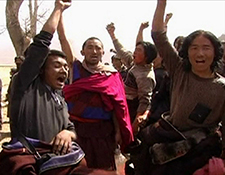
Protests continued to grow – in Ngaba a crowd swelled to around 300 people, waving Tibetan flags and shouting pro-independence slogans. Protesters replaced Chinese flags on a number of official buildings with Tibetan national flags to a cheering crowd. In Dartsedo, Kham acts of resistance continued despite the massive show of force by Chinese security forces.
Audio:
“Horsemen riding down from the mountain to lead a protest”
Tania Branigan, The Guardian
Numerous large and small scale protests broke out across Tibet despite the extreme numbers of Chinese armed police and security forces who had descended on the area to curb the uprising. After days of protests in the different Tibetan areas of Gansu Province which saw the deaths of scores of Tibetans, the Chinese government sent thousands of troops on foot, in trucks and helicopters into the area in an attempt to curb the flow of and hunt for protesters. Public notices both in Tibetan and Chinese language were posted in multiple areas warning protesters – or criminals as the notice called them – to surrender by midnight of 25 March.

Students, nuns and monks, and lay-Tibetans continued to resist across Tibet with courage against Chinese security forces. In Golog, eastern Tibet, protesters removed a Chinese flag and replaced it with the banned Tibetan national flag, and students at Qinghai Nationalities University led a solidarity protest for those Tibetans killed for the second consecutive day. In Kardze around 50 monks, nuns and lay people took to the streets.

Protests continued to spread – In Malho, eastern Tibet, hundred of Tibetans from at least four different villages came together in a mass protest carrying images of the Dalai Lama and the Tibetan national flag, and shouting “Freedom for the Tibetan people’ and “Release the Panchen Lama”. At Serlho Monastery monks held a peaceful demonstration and were joined by hundreds of local Tibetans, mainly nomads, demanding the Dalai Lama be allowed to visit Tibet. At A-tsok Monastery monks protested shouting “Free Tibet” and displaying Tibetan flags. Chinese military continued to surround monasteries and crackdown hard on any protests. Monks and nuns were forced to undergo “patriotic re-education.”
The 13th consecutive day or protests, large and small – in Chentsa, eastern Tibet, 800 Tibetans from a number of villages joined together in protest. The demonstration was met with a large mobilisation of Chinese paramilitary troops. Monks and nuns continued to rise at nunneries and monasteries across Tibet; the crackdown included Chinese “Work teams” forcing monks and nuns to sign documents stating that they had “wrongfully” taken part in the recent pro-independence demonstrations.
Around 200 Tibetans staged a peaceful demonstration in Drango, Kardze, chanting “Long live the Dalai Lama” and “Freedom for Tibet”. The protesters were met by a large number of armed police and security who fired live ammunition indiscriminately into the protesting crowd; at least one monk, 18 year-old Kunga, died. In Golog more than 50 protesters staged a non-violent protest; all protesters were arrested.
Wide-scale protests continued for the 15th successive day despite heavy military presence across Tibet. In Tsolho, Amdo 100s of Tibetans from all walks of life held a solidarity march. Many marchers were seen carrying traditional prayer wheels in their hands while reciting prayers, a huge banner was held up reading “Peace, Democracy. We mourn and pray for our people who lost their lives”; the following day authorities raided suspected leaders’ homes. In Drango County more than 400 monks held a peaceful protest in solidarity against Chinese rule and vowed to stand with each other in solidarity.
Audio:
“I’m not sure they realised how much criticism they would face”
Tania Branigan, The Guardian
Two weeks of consistent protests saw Chinese security forces round-up and detain protesters in different parts of Tibet; in the Golok area hundreds of Tibetans were forced to hide in the mountains. In Kardze, eastern Tibet, protesters expressed their frustration by writing “Tibet is an independent country” on Chinese currency and throwing the money in the air.
International journalists arrived in Lhasa to see China’s “harmonious society.” As the journalists were taken on the carefully-orchestrated media tour of Lhasa’s Jokhang Temple, about 30 monks from the monastery interrupted an interview and spoke openly about the situation inside Tibet. The monks maintained that the Chinese authorities were hiding the truth and that their accusations against His Holiness the Dalai Lama were false. Chinese authorities hurried the journalists away from the temple, but footage of the brave, emotional monks was captured and broadcast around the world.
After days of continued protest and unrest in Ngaba, eastern Tibet, Chinese Armed Police raided Kirti Monastery. They ransacked the monks’ living quarters and took away pictures of the Dalai Lama; around 600 monks were arrested. Around 30 Tibetans who had been arrested a few days earlier were paraded around the street of Ngaba County in a military truck to intimidate local Tibetans into ceasing with protests. At Nera Monastery, Central Tibet, a lone monk pasted posters up calling for the return of the Dalai Lama to Tibet.
Monks in central and eastern Tibet continued to resist the authorities’ attempts to exert control; Shiwa Monastery, eastern Tibet, a monk who had been forced into “patriotic re-education” classes shouted “Free Tibet” and “the Dalai Lama should be welcomed to Tibet”, and military personnel arrived to suppress the determined monks; Zigar Monastery, central Tibet, posters were displayed with “Free Tibet” and “China leave Tibet” slogans. Kardze, eastern Tibet a convoy of trucks filled with Chinese military soldiers arrived and the soldiers did house to house checks for pictures of the Dalai Lama and other pro-Tibet literature.
20th consecutive day of protests stretched across Tibet – Tibetans in multiple areas continued to rise up; at Wara Monastery, Central Tibet, monks staged a peaceful protest that ended after senior lamas intervened to stop a bloody crackdown. Monks from Shiwa Lhathim Monastery, eastern Tibet, marched towards local government offices shouting pro-independence slogans. Hundreds of students in Tsolho, eastern Tibet held a peaceful protest with banners and pamphlets.
Tibetan performers, teachers and poets were arrested and taken into custody in Amdo, on suspicion of political activism. Tibetan rap artist Golok Dabe was arrested in connection with helping the monks from Labrang Monastery to print the banned Tibetan national flag and photos of His Holiness the Dalai Lama.
Protests continued across Tibet and Chinese authorities ramped up a crackdown on an enormous scale. Tibetan farmer, Dawa, died after being arrested for taking part in a peaceful protest; he was reportedly tortured by Chinese prison guards. Jamyang Kyi, a well-known Tibetan musician, writer and broadcaster, was taken away by plain clothes state security officers from her office in Siling (Ch: Xining) city. Read News – Guardian; Tibetan singer missing after arrest by Chinese officials
A new phase of Tibetan defiance: Around 200 nuns from Ratroe Nunnery. eastern Tibet, set off in a peaceful procession in solidarity with Tibetan protesters who had lost their lives in the uprising across the Tibetan plateau. The nuns were forcibly returned to their nunnery.
Despite much pressure, 200 monks from Ba-Chodae Monastery, Bathang County, Kardze refused to sign official documents to support China’s allegations that the Dalai Lama was behind the protests.
Hundreds of Tibetan students from boycotted classes in protest of the recent crackdown on Tibetan demonstrators in the region
More than 300 monks and hundreds more local Tibetans in Kardze staged a peaceful protest to demand the release of detained monks. The demonstrators were confronted by armed security personnel and live ammunition was fired at the crowd, killing at least 14 Tibetans. Further protests in other parts of Kardze included groups of monks protesting with Tibetan flags, shouting slogans such as “His Holiness the Dalai Lama should be welcomed back to Tibet” and “Tibet is an independent country.”
In Sog County very tight restrictions were implemented and locals were refused to leave the county; “patriotic re-education” were reported to be mandatory.
A large group of monks at Thang-kya Monastery, Chamdo, held a protest shouting slogans calling for freedom of speech and religion and demanding an independent Tibet. Many of the monks were detained. Chinese police used the detentions to intimidate other Tibetans, threatening that if more people protested they would also be punished.
24th consecutive day of mass protests across Tibet.
In Lhasa foreign students at the Tibet University were banned from leaving the campus and for over a week their communication devices were disconnected.
At least 30 Tibetans were arrested in Malho for taking part in peaceful protests and a young monk from Ngaba Namtso Monastery was reportedly beaten to death by the Chinese security forces.
A crowd of about 1,000, monks and lay-Tibetans, marched from Mintso Monastery saying prayers for those killed in protests. Several hundred armed police stopped the march and opened fire on the crowd; at least 15 were seriously injured. Before phone contact was cut, a witness reported, “Please tell the world what we are doing here and that the Chinese are waging a violent crackdown”
At Lingque Temple, Drango County at least 400 monks, nomads, local residents and students held a peaceful prayer ceremony. As the crowd grew police became anxious and ordered the ceremony to a halt, but the participants refused to leave and the stand-off lasted for several hours. At one point, the 62 police opened fire to disperse the protesters, who were demanding the return of the Dalai Lama; about ten people were wounded.
Chinese security forces prevented a group of monks from Nyatso Monastery, Tawo County, from carrying out a candlelight vigil cum Buddhist ritual for Tibetans who died in the recent protests. Chinese security forces fired on the monks, killing and injuring at least three of them.
Champa Phuntsok, Chairman of the ‘Tibet Autonomous Region’ stated that Chinese authorities had detained nearly 1,000 Tibetans in Lhasa. Further sources reported that all three major monasteries around Lhasa were on lockdown, sealed off with the presence of hundreds of armed personnel.
Chinese authorities closed down Taktsang Lhamo Kirti Monastery school after a number of the Tibetan students had taken part in protests. Students were sent back to their respective homes after the closure.
In Lhasa, 40 Tibetans, some who were on pilgrimage, were sent back to their home-towns because they were not permanent residents of Lhasa.
Fifteen Labrang monks approached international journalists on a State-run media tour carrying the banned Tibetan flag and banners reading “We have no freedom of speech”. The monks shouted, “We want freedom, we want human rights and we want Dalai Lama to come back”.
They also told that “we are not against Olympic but want human rights of Tibetans respected”. Shortly after the media visit to the area, two monks- Thabkhey and Tsundue, who definitely spoke out in front of the foreign reporters, are known to have been disappeared.
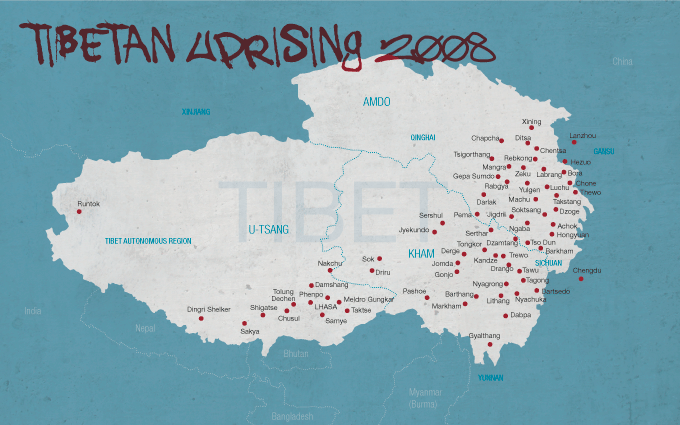
Map showing the locations of incidents during the Tibetan uprising 2008.

